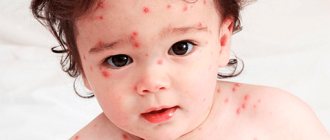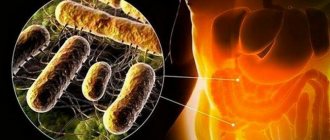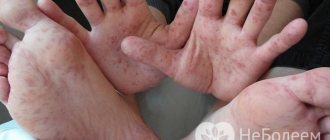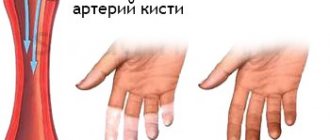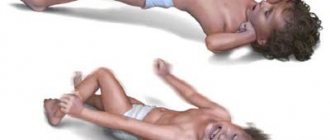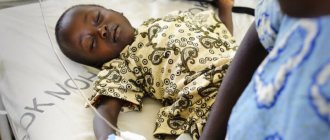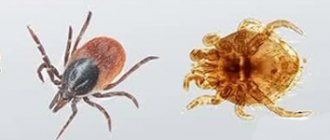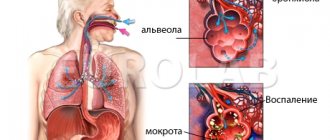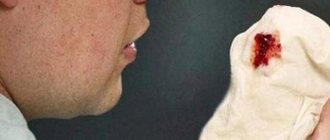The text is presented for informational purposes only. We strongly urge you not to self-medicate. When the first symptoms appear, consult a doctor. We recommend reading: “Why you can’t self-medicate?”
Coxsackie viruses are a type of enteroviral infection that affects both adults and children. It has several dozen symptoms that differ significantly from each other and can be isolated or combined, falling under one or another form of development of the disease.
Lately, people have been hearing more and more news about this infection. Outbreaks of viral diseases periodically cause panic among the population in different parts of the world.
The virus was first officially identified, described and named in the 50s of the 20th century. However, this does not mean that there were no cases of infection before. For example, in Spain at the end of the 19th century, an outbreak of myalgia was recorded, and in the first half of the 20th century, serous meningitis became more active in America and France. Both of these events can be attributed to the activity of the Coxsackie virus.
In 1948, American scientists Gilbert Dalldorf and Grace Sickles, while searching for a cure for polio, discovered traces of a previously unknown virus in the stool of polio patients. The isolation of a new strain of viral microorganisms occurred in the city of Coxsackie, which predetermined their name.
The last fairly serious case of the epidemic was recorded in 2007 in Eastern China: then 22 children died, more than 800 people were infected and more than 200 were hospitalized. Prior to this, the most high-profile outbreaks of the Coxsackie virus occurred in 2002 in Greece (3 people died, 46 were sent to hospital for treatment), and even earlier, in 1997 in Malaysia, when 30 children died.
A major shake-up for residents of Russia and Ukraine was the summer 2017 holiday season, when a family of tourists from Ukraine brought home, in addition to souvenirs and suntans, symptoms of the Coxsackie virus, and it affected both children and adults. Thanks to social networks, the situation received significant attention. In the media, this case was called the “Turkish infection” or “Turkish virus,” although it is fair to note that Coxsackie is also found in other resort countries. The situation contributed to the development of panic around the possible spread of the disease. And panic, as we know, is best dispelled by specific and relevant information. What is the Coxsackie virus, how is it transmitted and does it really pose a serious danger to humans?
Methods of transmission and ways of developing infection
Coxsackie viruses are representatives of several types of RNA-containing enteroviruses that reproduce well in the gastrointestinal tract.
The infection is most common in latitudes with a temperate climate - in such areas the season of highest incidence is summer and autumn.
The main method of infection is airborne; the fecal-oral route of transmission of viruses is also common, that is, through household items, dishes, drinks and food, dirty hands, unwashed vegetables or fruits. There are frequent cases of infection through swimming in water bodies. Possible infection of the fetus in the womb.
Coxsackie viruses are intracellular parasites. Once in the human body, the virus penetrates the mucous membrane of the nasopharynx or Peyer's patches of the intestine. It multiplies in the lymph nodes, after which the viruses end up in the blood and are spread throughout the body with its current. By spreading in this way, the virus penetrates the cellular structure of internal organs and causes inflammatory processes in them. The largest number of viral particles settle in neurocytes, skin, liver, kidneys and transverse muscle tissue, where they begin to parasitize healthy cells. After this, the immune system is involved in the process of suppressing viral activity: the T-lymphocytes it produces begin to destroy infected cells and the viral particles themselves.
Types of Coxsackie virus
The study of infectious pathogens continues to this day, since more than 30 varieties or strains have been identified so far, and there is a possibility that this is not the limit.
Scientists divide all currently known types of Coxsackie viruses, depending on the antigenic properties of the serogroups contained in these strains, into 2 groups:
- Group A: infects the skin and mucous tissues, causing hemorrhagic conjunctivitis, aseptic meningitis, diseases of the upper respiratory tract, enteroviral vesicular stomatitis with exanthema, as well as the so-called herpangina.
- Group B: affects internal organs - heart, liver, pancreas, lining of the lungs, causes pericarditis, myocarditis, hepatitis not associated with hepatotropic viruses.
Both varieties are stable in the environment, but are killed by ultraviolet irradiation and disinfectant solutions such as chloramine and bleach. Boiling also has a destructive effect on pathogens. Alcohol and low temperatures have no effect on virus cells and can survive for several years when frozen.
Symptoms and manifestations of infection
From the moment of infection it can take from 2 to 10 days. You can understand how the disease caused by the Coxsackie virus begins by looking at the general symptoms of all forms that the virus can take - a rash on the body, especially on the extremities, diarrhea and fever. The fastest symptoms appear are high fever (up to 40 degrees), lack of appetite, and indigestion. The head may hurt, the root of the tongue becomes covered with a white coating. Less obvious signs include enlarged lymph nodes, liver, spleen, and increased heart rate.
The specific manifestations of the virus depend on which organs contain the greatest amount of infection. These may be muscle spasms and cramps, nausea, vomiting, severe fever, enlarged liver, abdominal pain, signs of conjunctivitis, and other symptoms.
We recommend the article: Coxsackie symptoms
Forms of the course and development of a viral disease
Depending on which organs the pathogen is predominantly localized in, the disease can manifest itself in various forms:
- flu-like;
- polio-like;
- intestinal form;
- hepatitis-like;
- in the form of enteroviral exanthema;
- herpetic sore throat;
- hemorrhagic conjunctivitis;
- pleurodynia;
- serous meningitis;
- in the form of disturbances in the functioning of the heart.
The first type is the mildest, its symptoms resemble intoxication during the flu, and is characterized by a sharp increase in temperature to 39-40 degrees, which quickly passes. Forms such as serous meningitis, pleurodynia or hepatitis-like can have more serious consequences, so seeking medical help in these cases is simply necessary.
In addition, doctors distinguish between latent and acute forms of the disease:
- In the first case, if the infected person’s immunity is active, no symptoms will appear, and the body’s defenses will simply suppress the pathogen.
- The second form means that the immune system is not able to contain the spread and reproduction of the virus, and the disease develops with characteristic symptoms.
Incubation period and its features
The time from the moment of infection, during which the infection actively multiplies in the body and disperses in the body in order to manifest itself as a disease, is called the incubation period. When infected with Coxsackie, it lasts from two to seven days. In this period:
- At the first stage of the development of the disease, viral particles accumulate in the intestines and on the mucous membrane of the nasopharynx (if the virus is detected at this stage, it will be quite easy to recover).
- At the second stage, the virus enters the blood and is transported throughout the body, settling in the lymph nodes, muscles, and organs.
- The third stage is a pronounced inflammatory process, when the virus begins to destroy cells of tissues and organs, manifested by severe intoxication.
The name “hands-foot-mouth” most indicatively characterizes the symptoms of the disease that appear in this case: on the limbs, palms, and feet, as well as on the oral mucosa and around the mouth. The rash is a viral pemphigus, that is, blisters filled with serous contents that burst over time, forming crusts. After some time, the skin on the affected areas of the rash peels off, especially between the fingers and around the fingernails and toenails - this process is a specific sign of hand-foot-mouth syndrome.
Pleurodynia
Pleurodynia is inflammation of the muscles in the chest. It is associated with pleuralgia - sudden attacks of sharp chest pain that worsen with deep inspiration. The pain syndrome can also be localized in the abdominal area. The sensations take on the character of waves or spasms. Pleurodynia usually goes away on its own within about five days, but attacks may recur after 7 to 14 days.
Features of the course of the disease in children, treatment methods
The children's population is susceptible to infection with the Coxsackie virus much more often than adults. The main risk group suffering from infection are children under 10 years of age.
A characteristic manifestation in children is the “hands-foot-mouth” symptom: a condition when, after a sudden high fever that lasts 1-2 days, a rash appears on the limbs, around the mouth and on the mucous membranes of the oral cavity. Also, children with Coxsackie often have constipation rather than diarrhea. In general, children experience the disease more severely than adults and require more careful care.
Primary manifestations of Coxsackie infection in a child often do not allow one to correctly identify the virus that caused the disease. The first thing parents pay attention to is a sudden high temperature, accompanied by symptoms of intoxication: weakness and malaise, increased fatigue. The child looks tired and may refuse to eat. Then ulcers appear on the oral mucosa, rashes and itchy skin. Moreover, the latter can cause discomfort so much that it provokes dizziness and insomnia.
In this case, it will be difficult to feed the baby, especially if there are painful wounds in the mouth. However, cool, clean water should definitely be constantly supplied to the body. To anesthetize wounds in the mouth before feeding or drinking, you can use special gels with an anesthetic effect: Holisal, Kamistad, Holitsest. But it is not worth feeding a child heavily during a period of acute illness, when he refuses to eat due to pain in the mouth when swallowing and simply lack of appetite due to illness.
As with other acute infectious diseases, calling a pediatrician should be urgent.
General therapy for the disease includes influencing the symptoms in order to remove them completely: antihistamines, anti-inflammatory drugs, adsorbents and other groups of drugs are used. For herpangina caused by Coxsackie, children are often prescribed Acyclovir for oral or external use, which is an erroneous prescription, since herpangina has only a name in common with herpes diseases, and the causative agent is not a herpes virus, and this drug does not affect the process in any way diseases
Manifestations in the form of a skin rash in a child are often mistaken for chickenpox, especially in the first few days of its appearance. However, the rashes caused by Coxsackie also cover the palms and feet, unlike chickenpox, in which the feet and palms remain clean.
Should I cancel my trip or take a risk?
The choice is always up to each individual. The situation in Turkey is not completely clear. Some people generally consider everything that is happening to be a provocation and the machinations of competitors. Whether this is true or not, outbreaks of the Coxsackie virus often occur in warm coastal countries with large concentrations of people (particularly children) in hotels. And there is enough information about this on the Internet to track the frequency of these epidemics. If you still decide not to give up your vacation and spend it right now in this country, then, firstly, take with you a first aid kit with the necessary supplies.
Infection of adults with Coxsackie virus
Recently, the number of sick adults has been increasing.
The likelihood of contracting Coxsackie increases in people with immunosuppression. In such people, the disease is more complex and the treatment process takes longer. Autoimmune diseases, human immunodeficiency syndrome, chemotherapy for cancer, recent operations, especially organ transplantation, are the most serious factors in reducing immunity and body resistance.
Among the possible consequences of the transferred Coxsackie virus in adults:
- pericarditis and myocarditis;
- encephalitis;
- diabetes;
- paralysis.
Myopericarditis
Myopericarditis is one of the most dangerous signs of infection with the Coxsackie pathogen. The virus in adults (the symptoms that are most often observed are listed above), fortunately, extremely rarely causes such disorders. Myopericarditis is an inflammation of the heart and its lining, and the patient’s condition can be either mild or severe. In the latter case, the disease can lead to heart failure, heart attack or death. Most often, myopericarditis is observed in young patients leading an active lifestyle. Symptoms include shortness of breath, chest pain, fatigue and swollen legs. The damage to the heart may be permanent.
Infection, detection and characteristics of the course of infection in pregnant women
The question “is the Coxsackie virus dangerous during pregnancy” does not have a clear answer. It all depends mainly on the immunity of the expectant mother.
To detect the presence of the virus in a woman, she may be prescribed the following tests:
- serological blood tests (for the presence and quantity of specific antibodies);
- PCR of the virus, which allows you to determine its genotype.
Pregnant women, like other groups of people, become ill with this infection through airborne or nutritional contact with the virus. The incubation period lasts from 4 to 6 days. In summer and autumn, as well as with high humidity, the activity of the virus increases, and it becomes even more dangerous for the expectant mother.
Pregnant women are especially susceptible to infection with Coxsackievirus type 16A. The first signs of infection are disturbances in the digestive tract, a rash in the form of small blisters on the feet, hands and mouth. Such blisters strongly resemble stomatitis.
There are several ways of infection of the fetus from the mother:
- Perinatal (through vaginal secretions, blood).
- Transplacental if the concentration of the virus in the blood is very high, or if there is an exacerbation of a chronic infection.
- Postnatal (via breast milk or other sources).
The virus poses a danger to the expectant mother because, due to the special state of her body, her immunity is already reduced, and Coxsackie suppresses it even more. In such cases, there is a high probability, firstly, of the disease progressing in severe forms, and secondly, of infection with other infections or exacerbation of existing ones.
Infection with the Coxsackie virus in the first trimester of pregnancy can lead to the death of the embryo or delayed fetal development, spontaneous miscarriage, and prematurity. In the second trimester of pregnancy, infection leads to respiratory failure and global cognitive defects of the fetus.
To prevent infection, pregnant women should be especially careful about their own hygiene: keep their hands and food clean, drink more fluids, and avoid contact with sick people.
If such contact is unavoidable, you must wear a medical mask and gloves and carry out thorough disinfection.
Nutrition
General recommendations:
- Feed in small portions, but often (5-6 times a day).
- Avoid salty, spicy and sour foods.
- Prepare dishes by steaming, baking or boiling.
- Include foods rich in vitamins (fruits, vegetables) in your diet.
You can treat the disease with folk remedies:
- Rinse your mouth with chamomile decoction.
- Drink tea with cinnamon and honey. It soothes a sore throat.
- Eat more garlic, which resists viral infection.
Diagnosis and treatment of viral infection
The definition of Coxsackie in the body cannot always be based only on external manifestations, since they may be similar to other diseases. You can more accurately diagnose the Coxsackie virus in a sick person using laboratory tests:
- PCR analysis for the virus in nasopharyngeal swabs and feces is the most accurate method that allows you to determine the genotype of the virus;
- determination of the amount and activity of specific antibodies in the blood - serological analysis of blood serum for the presence of antibodies to the Coxsackie virus;
- taking a puncture of cerebrospinal fluid.
In order to quickly get rid of the disease and prevent complications from occurring, the first thing to do when any signs indicating Coxsackie appear is to seek medical help, even if the person is on vacation. There is no specific therapy against the disease caused by the Coxsackie virus, like other enteroviruses. Treatment is symptomatic. If there are no serious complications, it is acceptable to be treated at home.
Medical products (drugs, medicines, vitamins, medicines) are mentioned for informational purposes. We do not recommend using them without a doctor's prescription. We recommend reading: “Why can’t you take medications without a doctor’s prescription?”
A set of therapeutic measures in this case includes bed rest, taking immunomodulatory, anti-inflammatory drugs and drugs containing paracetamol. In young children and the elderly, infection with the Coxsackie virus can cause a complication in the form of encephalitis, so therapy should be carried out under the supervision of a pediatrician.
Treatment of a disease in a child includes general therapeutic measures (bed rest, refusal to attend kindergarten or school, a balanced diet with sufficient fluids and vitamins), as well as symptomatic effects:
- If there are ulcers and wounds in the mouth, as well as throat diseases, special antiseptic rinses and sore throat tablets are used.
- The skin rash must be smeared with “green paint”, Calamine or Fucarcin in order to prevent further spread of the infection.
- Muscle pain, fever and headache can be relieved with, for example, Ibuprofen or children's Paracetamol.
- In case of excessive vomiting and diarrhea, doctors recommend Enterofuril, and special solutions (Regidron) can be used to restore the water-salt balance.
- In case of severe infection, it is recommended to add interferon inducers to therapy.
- If a child suffers from signs of intoxication, you need to give him absorbent drugs like Enterosgel or activated carbon.
- For those who are concerned about how to relieve severe itching in a baby, antihistamines are offered (Zodak, Finestil, Erius).
The use of antibiotics is not always advisable - they are prescribed only in the case of secondary development of bacterial infection against the background of an enteroviral disease. If after 2-3 days the child does not feel better, and signs of meningitis appear, you should immediately seek medical help again.
Publication on the topic: Treatment of Coxsackie
Medications
In the standard course of Coxsackie, symptomatic therapy is used, which may include the following medication forms:
- to relieve intoxication, diarrhea, vomiting, adsorbent drugs are used (Enterosgel, activated carbon, etc.);
- after intestinal symptoms return to normal, it is advisable to take probiotics;
- on days when there is a fever, antipyretic medications are taken;
- Antiseptic agents (Orasept, Tantum-Verde, Hexoral) are used to treat the mucous membranes of the mouth and throat;
- to relieve skin itching, which is especially difficult for children to tolerate, you need to take antihistamines (it is advisable to lubricate the rash areas with soothing and antiseptic ointments and gels);
- during periods of diarrhea and high temperature, which lead to dehydration, be sure to drink plenty of fluids using medications that regulate water and electrolyte balance;
- To increase the body's overall ability to resist the virus, it is recommended to take interferons or immunoglobulins.
All medications must be prescribed by your doctor. When bacterial infections occur (on the skin due to scratching acne, in the nasopharynx and other organs), appropriate antibiotics are prescribed.
Possible complications after illness
How dangerous is Coxsackie for children and adults? Not only does it cause symptoms that are very similar to a dozen different diseases, but it can also cause the appearance of some diseases. Incorrect and untimely consultation with a doctor increases the chances of getting complications from the virus. Among them are encephalitis, viral meningitis, paralysis, myocarditis, insulin-dependent diabetes mellitus, and pleurodynia.
In children, in addition to the problems listed, a purulent sore throat, partial paralysis, as well as changes in the nails may occur (as a rule, 4-8 weeks after recovery, the nails may partially peel off, change color and shape, become brittle and brittle, and even fall off completely, followed by replacement of the renewed nail plate).
Forecast of the course of the disease and recovery
Timely consultation with a doctor and correct diagnosis of the virus increases the likelihood that the disease will pass quickly and will not cause significant harm to the body. In case of a mild infection, the person returns to the usual rhythm of life after 3 days. In more severe cases, recovery lasts up to two weeks, in rare cases, for example, with manifestations of encephalitis - up to 6-8 weeks.
With properly selected therapy, the child’s recovery occurs in approximately 10-14 days. After two weeks, the last lesions and blisters on the skin heal. Additionally, in the period after the end of the active stage of the disease, it is useful to give the baby vitamin complexes containing vitamins A, , , and B. For six months after recovery, it is not recommended to give the child any vaccinations.
There are several possible outcomes of the disease:
- the person completely gets rid of the virus and recovers;
- nerve cells and organs retain virus particles for some time;
- a person becomes a carrier of the virus.
Spreading
The infection is transmitted from person to person. The virus is present in the secretions and bodily fluids of patients and can spread through contact with respiratory secretions. If an infected person rubs his nose (and the disease is characterized by a runny nose) and touches any object, the virus will remain on the surface of this object, and it will become a source of infection. A healthy person only needs to touch a contaminated item and then touch their mouth or nose to spread the disease.
People with an eye infection (conjunctivitis) can infect others by repeatedly touching their eyes and objects. Conjunctivitis develops very quickly and can appear on the first day of infection. Pathogenic microorganisms are present in feces, which is the reason for the spread of infection among children in nurseries where diapers are used.
Prevention of infection with Coxsackie viruses
To date, no vaccine has been developed against the virus; this is due to the large number of serotypes and variability of the virus. Considering that sometimes the disease can pass relatively easily and in just 3-4 days, and in some cases it can occur with more severe symptoms and consequences, it is better to take care to reduce the likelihood of infection as much as possible.
Alas, doctors can only offer careful personal hygiene as preventive measures. However, this can only protect against infection through nutrition. This method is not a panacea for the virus, because it is also transmitted by airborne droplets.
During the epidemic period, it is recommended to avoid crowded places and beaches; it may even be worth rescheduling your trip to a resort if an epidemic of the Coxsackie virus is registered there at that time. It is interesting that even a person who has already recovered remains a source of viral particles for 2 months after the end of the illness; therefore, one can become infected from him.
If we are talking about children, schools and kindergartens may declare a quarantine and stop classes during this time. If the child shows the first signs of infection, he must be protected from communication with other children.
Where can you get infected?
Since the virus is transmitted in the three most common ways, you can get infected anywhere. Most often, a child becomes infected in children's groups (in kindergartens/nurseries, schools, playgrounds, etc.). Therefore, it is not surprising that the virus broke out in Turkey today. This is a favorite vacation spot for families with small children. According to experts, a child’s highest chance of becoming infected is in the pool. Regular pool water filtration does not kill virus cells. They can only be dealt with by boiling, ultraviolet light, a concentrated bleach solution or a 0.3% formaldehyde solution. And given the “density” of children in pools during the hot season, it is simply impossible to completely disinfect the water.
Common questions about the Coxsackie virus
Can the virus be chronic?
In some cases, the disease seems to have already disappeared, the symptoms have gone away, the state of health has returned to normal, but the viral particles still remain in the organs and cells for an indefinite time. In this case, we can talk about the transition of the virus to a chronic state, that is, a person does not have any clinical manifestations of the disease, but the infection still lives and multiplies in the intestines or mucous membranes. A similar situation happens to those who have suffered from Coxsackie asymptomatically.
How long is a person with Coxsackie virus contagious?
If we are talking about chronic virus carriers, they can release virus particles into the environment for several years after the illness.
The period of infectiousness begins from the beginning of the incubation period. Those who have completely recovered from the virus are contagious for 10-20 days after recovery. In some cases, a person may be contagious for another 2 months if virus particles are present and multiplying in the body.
Does immunity to the Coxsackie virus develop, and is it possible to get sick again?
After the infection has entered the blood and internal organs, the person’s own immune system is involved in the process of fighting it, which produces certain virus-neutralizing type-specific antibodies that persist throughout life. Type-specific immunity is formed. To destroy viral particles and infected cells, there is age-related acquired immunity as a result of latent forms of the disease.
Infants under 6 months of age who are breastfed have antibodies in their blood to various viruses that are transmitted from the mother with milk - they reduce the risk of infection for the child, but do not completely eliminate it.
What happens to nails after illness
One of the consequences of a previous Coxsackie infection is deterioration of the condition of the nails. In addition to the fact that they weaken greatly, they can change shape, peel and break, in some cases the nails peel off, that is, the nail plate simply peels off from the finger, and a new growing nail is already visible under it.
Causes
The infection described belongs to the genus of enteroviruses. There are two known groups of microorganisms (A and B), each divided into several serotypes. Gastric juice is not able to destroy pathogenic flora called Coxsackie. The virus causes characteristic symptoms in adults within a couple of days after entering the body. The greatest danger of infection remains during the first week of illness, but the risk of infection exists even a week after the symptoms disappear. The virus parasitizes for the longest time in the bodies of children and people with weakened immune systems.
